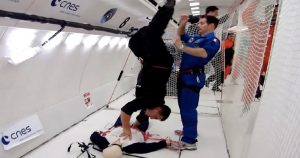
Know Here: The First Aid Secrets Of The Astronauts
A plethora of measures must be taken when it is about mission into space. Injuries and illness during long-range space journeys will present a whole new range of challenges for astronauts, according to presentations given this week at Euroanaesthesia 2017, a Congress of Anesthesiologists held in Switzerland’s Geneva.
Prominent doctor Matthieu Komorowski of Charing Cross Hospital in London, UK, points out that space missions are inherently hazardous, and can cause medical conditions never encountered on Earth.
“The exposure to the space environment itself disturbs most physiological systems and can precipitate the onset of space-specific illnesses, such as cardiovascular deconditioning, acute radiation syndrome, hypobaric decompression sickness, and osteoporotic fractures,” he says.
Anything more than low-earth orbits, real-time medical advice or telesurgery will be impossible, meaning that space crews will have to be able to deal with medical emergencies – and perhaps perform life-saving operations – without expert oversight.
Because of this possibility, Komorowski says, it is critical that all mission crewmembers receive at least basic medical training. “Duplication of skills will be critical to enhance crew safety, especially if the doctor on board himself becomes ill, injured, incapacitated or dies,” he includes.
There are certain measures that are already followed by NASA, as per the current policy, astronauts must not have few unessential parts, such as appendix and wisdom teeth.
Despite these measures taken, there are still chances of illness and injury remain likely. Komorowski says it is important to prepare for the fact that some of these may not be treatable away from home.
“During future space exploration missions, the crew must prepare for non-survivable illnesses or injuries that will exceed their limited treatment capability,” he notes.
Jochen Hinkelbein, speaker at the Congress, of University Hospital of Cologne in Germany points out that some life-saving procedures, notably cardiopulmonary resuscitation (CPR), will be almost impossible in microgravity, as per him, current space missions carry only a small risk of heart attack, he says, but that will change in the next few years.
“Since astronauts are selected carefully, are usually young, and are intensively observed before and during their training, relevant medical problems are, fortunately, rare in space,” he says.
“However, in the context of future long-term missions, for example to Mars, with durations of several years, the risk for severe medical problems is significantly higher.”
Now, Hinkelbein will report on studies that indicate the best method of CPR for confined spaces with almost no gravity is a procedure known as the Evetts-Russomano method, this study involves wrapping one’s legs around the heart attack victim to prevent her or him floating away while simultaneously compressing the chest.